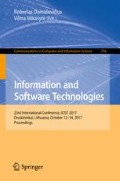Abstract
This paper confirms the existence of statistical arbitrage opportunities by employing the nanosecond historical data in high frequency trading (HFT). When considering the possible options, the Daniel Herlemont pairs trading strategy has been selected. In order pairs trading could operate, the pair selection algorithm had to be developed. Herlemont pairs trading strategy has not been tested before by using the nanosecond information and the proposed pair selection algorithm. The main objective of the given research is to test the pairs trading strategy in HFT by calculating the returnability in commodity futures market. The statistical arbitrage strategy attempts to achieve profit by exploiting price differences of the futures contracts. The strategy takes long/short positions when the spread between the prices widens with an expectation that the prices will converge in the future. In the given paper, the nanosecond historical data was provided by the Nanotick Company. The applied strategy has been subsequently tested with MatLab software.
Access this chapter
Tax calculation will be finalised at checkout
Purchases are for personal use only
References
Barry, E.J.: Hedge funds and financial market dynamics. Intl. Monetary Fund, p. 83 (1998)
Madhavaram, G.R.: Statistical arbitrage using pairs trading with support vector machine learning. Saint Mary’s University (2013)
Burton, G.M.: The efficient market hypothesis and its critics. J. Econ. Perspect. 17(1), 59–82 (2003)
Perlin, M.S.: Evaluation of Pairs-trading strategy at the Brazilian financial market. J. Deriv. Hedge Funds 15(2), 122–136 (2009)
Caldeira, J.F., Moura, G.V.: Selection of a portfolio of pairs based on cointegration: a statistical arbitrage strategy. Revista Brasileira de Financas 11(1), 49–80 (2013)
Herlemont, D.: Pairs trading, convergence trading, cointegration. Quant. Finan. 12(9) (2013)
Zubulake, P., Lee, S.: The high frequency game changer: how automated trading strategies have revolutionized the markets. Aite Group. Wiley Trading (2011)
Cifu, D.A.: FORM S-1, Registration Statement Under The Securities Act Of 1933. Virtu Financial, Inc. (2014)
AFM: Authority for the Financial Markets, High frequency trading: The application of advanced trading technology in the European marketplace (2010). http://www.afm.nl/~/media/files/rapport/2010/hft-report-engels.ashx. Accessed 20 Feb 2014
Aldridge, I.: High-Frequency Trading: A Practical Guide to Algorithmic Strategies and Trading Systems, 2 edn., p. 306. Wiley (2013)
Hagströmer, B., Norden, L.: The diversity of high-frequency traders. J. Financ. Mark. 16(4), 741–770 (2013)
Driaunys, K., Masteika, S., Sakalauskas, V., Vaitonis, M.: An algorithm-based statistical arbitrage high frequency trading system to forecast prices of natural gas futures. Transform. Bus. Econ. 13(3), 96–109 (2014)
Masteika, S., Vaitonis, M.: Quantitative research in high frequency trading for natural gas futures market. In: Abramowicz, W. (ed.) BIS 2015. LNBIP, vol. 228, pp. 29–35. Springer, Cham (2015). doi:10.1007/978-3-319-26762-3_3
Cvitanic, J., Kirilenko, A.: High frequency traders and asset prices (2010). SSRN: http://ssrn.com/abstract=1569067 or http://dx.doi.org/10.2139/ssrn.1569067
Carrion, A.: Very fast money: high – frequency trading on the NASDAQ. J. Financ. Mark. 16(4), 680–711 (2013)
George, M.J.: High frequency and dynamic pairs trading based on statistical arbitrage using a two-stage correlation and cointegration approach. Int. J. Econ. Financ. 6(3), 96–110 (2014)
Antoine, B., Cyrille, G., Carlos, A.R., Christian, W., Steffen, N.: High-frequency trading activity in EU equity markets. In: Economic Report, vol. 1 (2014)
Botos, B., Nagy, L., Ormos, M.: Pairs Trading Arbitrage Strategy in the Old and New EU Member States, ICFB (2014)
Vaitonis, M.: Porų prekybos strategijų taikymo gamtinių dujų rinkose tyrimas. Informacinės Technologijos 117–120 (2015)
Krauss, C.: Statistical arbitrage pairs trading strategies: review and outlook. IWQW Discussion Paper Series, No. 09/2015 (2015)
Miller, S.J.: The method of least squares. Mathematics Department Brown University (2006)
Vidyamurthy, G.: Pairs Trading – Quantitative Methods and Analysis, p. 210. Wiley, New Jersey (2004)
Vaitonis, M., Masteika, S.: Research in high frequency trading and pairs selection algorithm with Baltic region stocks. In: Dregvaite, G., Damasevicius, R. (eds.) ICIST 2016. CCIS, vol. 639, pp. 208–217. Springer, Cham (2016). doi:10.1007/978-3-319-46254-7_17
Vaitonis, M.: Pairs trading using HFT in OMX Baltic market. Baltic J. Modern Comput. 5(1), 37–49 (2017)
Bogoev, D., Karam, A.: An empirical detection of high frequency trading strategies. In: 6th International Conference of the Financial Engineering and Banking Society, 10–12 June 2016, Melaga (2016)
Miller, R.S., Shorter, G.: High frequency trading: overview of recent developments. Report, Washington, D.C., 4 April 2016
Drakos, S.: Statistical arbitrage in S&P500. J. Math. Financ. 6, 166–177 (2016)
Ahmet, G.: Statistical arbitrage in the Black-Scholes framework. Quant. Financ. 15(9), 1489–1499 (2015)
O’Hara, M.: High frequency market microstructure. J. Financ. Econ. 116(2), 257–270 (2015)
Goldstein, M.A., Pavitra, K., Frank, C.G.: Computerized and high-frequency trading. Financ. Rev. 49(2), 177–202 (2014)
Acknowledgements
We would also like to show our gratitude to the NANOTICK for providing with high frequency data in nanoseconds of 5 futures commodity contracts.
Author information
Authors and Affiliations
Corresponding author
Editor information
Editors and Affiliations
Rights and permissions
Copyright information
© 2017 Springer International Publishing AG
About this paper
Cite this paper
Vaitonis, M., Masteika, S. (2017). Statistical Arbitrage Trading Strategy in Commodity Futures Market with the Use of Nanoseconds Historical Data. In: Damaševičius, R., Mikašytė, V. (eds) Information and Software Technologies. ICIST 2017. Communications in Computer and Information Science, vol 756. Springer, Cham. https://doi.org/10.1007/978-3-319-67642-5_25
Download citation
DOI: https://doi.org/10.1007/978-3-319-67642-5_25
Published:
Publisher Name: Springer, Cham
Print ISBN: 978-3-319-67641-8
Online ISBN: 978-3-319-67642-5
eBook Packages: Computer ScienceComputer Science (R0)

